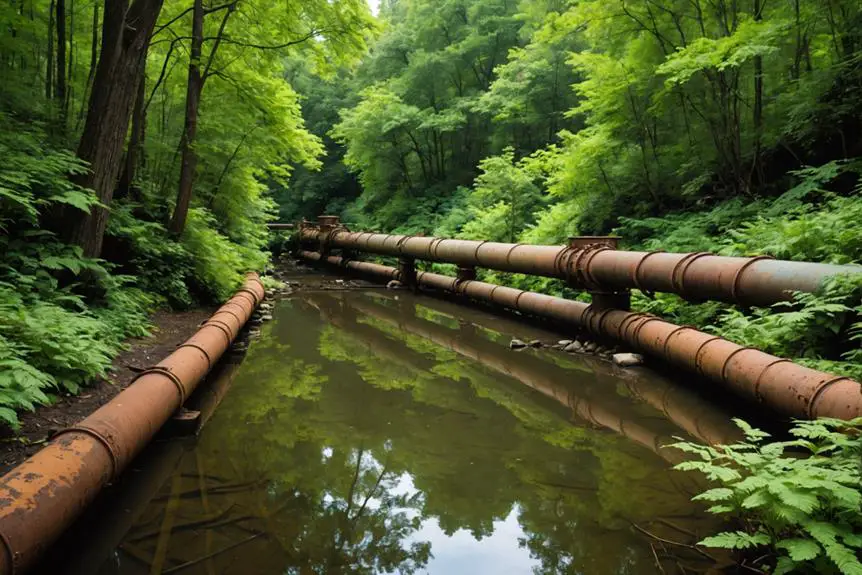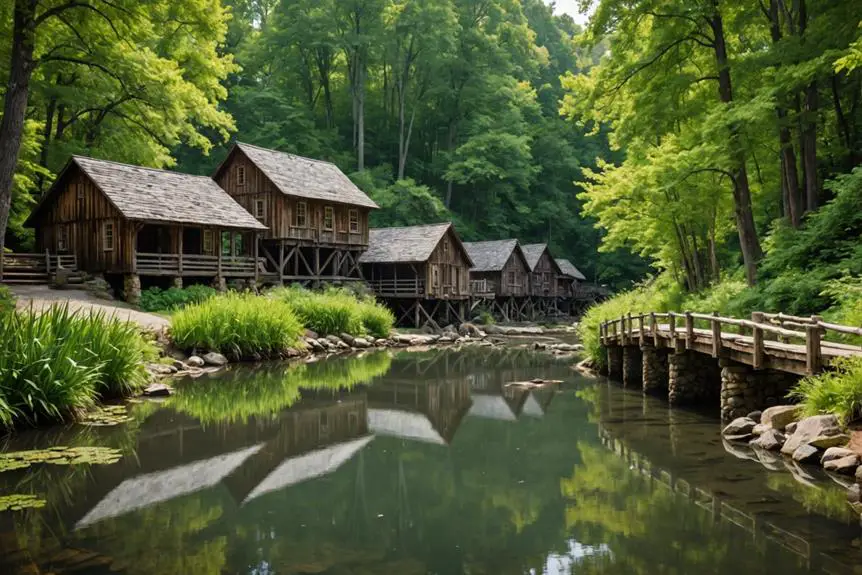Coldwater Creek's history as a fashion brand reflects a compelling journey through the realms of community values and environmental consciousness. Founded in the 1980s in Idaho, Coldwater Creek emerged as a lifestyle brand that captured the spirit of nature with its thoughtfully curated catalog of apparel and home goods. The brand emphasized quality and craftsmanship, resonating with customers who cherished the outdoors and sought to incorporate that connection into their everyday lives.
While the brand thrived, the surrounding environment faced significant challenges. The creek itself had a troubled past, marked by radioactive waste dumping from the Manhattan Project in the 1940s, leading to its designation as a Superfund site by 1989. This dual narrative of a fashion brand flourishing amidst environmental adversity highlights the importance of sustainability and community advocacy in the industry. Coldwater Creek not only celebrated nature through its products but also became a symbol of resilience and a commitment to health and environmental stewardship.
Historical Context of Coldwater Creek

The historical context of Coldwater Creek is rooted in a series of events that unfolded over several decades, shaping the environmental landscape of the area. Starting in the 1940s, Mallinckrodt Chemical Works improperly dumped radioactive waste from the Manhattan Project, marking the beginning of significant contamination concerns. This problem intensified with the negligent storage of radioactive materials in open piles, which persisted until the 1970s. Environmental factors contributed to the spread of these toxins, compounding the risk to local ecosystems and health.
Between the 1950s and 1970s, population growth and extensive construction activities further disturbed already contaminated sites, increasing exposure for residents. The cumulative impact of these actions led to Coldwater Creek being added to the Superfund National Priorities List in 1989, highlighting the urgent need for remediation due to serious health risks linked to the historic uranium processing.
As of now, cleanup efforts are projected to extend until at least 2038, reflecting the long-term consequences of past negligence in radioactive waste management. This timeline illustrates the ongoing struggle to rectify decades of environmental harm while underscoring the importance of responsible waste management practices moving forward.
Origins of Coldwater Creek
Often seeking a change from urban life, Ann and Dennis Pence found inspiration for Coldwater Creek after relocating from New York City to the picturesque landscapes of Sandpoint, Idaho. The serene environment, surrounded by the Selkirk and Cabinet Mountains, fueled their vision for a brand that reflected the area's natural beauty. Their encounters with local wildlife, such as bald eagles and black bears, further reinforced their desire to create a connection between nature and consumer products.
Initially, the Pences operated modestly from a closet in their two-bedroom apartment, focusing on novelty items that celebrated the region's charm. The brand's identity began to crystallize with the launch of its first catalog in January 1984, which featured 18 nature-themed products, including a unique $300 water phone designed to call humpback whales. This catalog marked the beginning of a journey that would evolve Coldwater Creek from a novelty-focused venture into an extensive line of clothing and accessories.
Throughout its growth, Coldwater Creek maintained a strong connection to the Mountain West heritage, ensuring that the essence of its origins remained central to its brand identity.
Launch of the First Catalog

How did a modest catalog become the foundation for a thriving brand? In January 1984, Coldwater Creek launched its first catalog, featuring 18 nature-themed items that reflected a unique vision. This original catalog was printed in a two-bedroom apartment's closet, showcasing the humble beginnings of what would become a well-known retail name. Among the offerings was an unusual $300 water phone designed for calling humpback whales, highlighting the creative spirit behind the brand.
This early catalog laid the groundwork for future expansion and innovation. Here are four key aspects that exemplify its importance:
- Diverse Product Range: The catalog included items like wind chimes and bird feeders, appealing to nature enthusiasts.
- Print Quality Evolution: The first four-color catalog was published in 1985, enhancing visual appeal and marketing effectiveness.
- Foundation for Growth: The original catalog opened doors to a broader product range, including jewelry and clothing.
- Cultural Impact: Just as the first atomic bomb marked a pivotal moment in history, this catalog signaled a shift in retail marketing strategies.
In essence, this launch was a pivotal moment for Coldwater Creek.
Growth and Evolution of the Brand
Throughout the late 1980s and early 1990s, Coldwater Creek consistently evolved its product offerings, shifting from a niche direct mail business focused on novelty items to a robust line of clothing and accessories. This change was driven by a commitment to high-quality materials and timeless designs, which resonated deeply with customers.
By 1996, the company celebrated impressive growth, achieving sales of $143.1 million and expanding its catalog considerably. Such achievements were made possible by unwavering customer support, which played a pivotal role in solidifying Coldwater Creek's reputation.
Here's a snapshot of the brand's evolution:
| Milestone | Impact |
|---|---|
| Change to clothing line | Broadened customer base |
| Sales of $143.1 million (1996) | Six consecutive years of growth |
| 40th Anniversary (2023) | Celebration of heritage |
| Commitment to quality | Fostered strong customer loyalty |
The brand's dedication to well-made designs and unexpected fashion twists contributed to lasting customer satisfaction. As a result, Coldwater Creek nurtured a vibrant community, united by shared values of nature and craftsmanship, ensuring its continued relevance in the marketplace.
Contamination Mechanisms

While the historical context of Coldwater Creek's growth is significant, the contamination mechanisms that affected the area raise serious concerns about public health and safety. Radioactive materials were stored in open piles near the creek until the 1970s, exposing them to environmental elements, which facilitated contamination. The creek itself acted as a pathway for radioactive contamination, allowing wind, rain, and flooding to disperse these materials into surrounding areas.
Key mechanisms of contamination include:
- Environmental Exposure: Open storage of radioactive materials allowed for environmental degradation and spread.
- Soil Porosity: The porous nature of the soil and underground caves facilitated the migration of radioactive materials far from their original sites.
- Construction Disturbances: Development in the 1950s to 1970s disrupted contaminated sites, redistributing radioactive materials into residential neighborhoods.
- Food Sources: Chronic inhalation and ingestion of radioactive materials from contaminated food sources and local vegetation have posed ongoing health risks.
The Environmental Protection Agency has recognized these issues, emphasizing the need for ongoing monitoring and remediation efforts to address the contamination problems in Coldwater Creek.
Health Impacts on the Community
The health impacts on the community surrounding Coldwater Creek are alarming and warrant serious attention. Between 2008 and 2011, residents reported increased cancer rates and unusual health issues, leading the CDC to investigate potential cancer clusters. The Agency for Toxic Substances and Disease Registry has linked these health impacts to exposure to radioactive material found in the creek, particularly Thorium-230, which the Army Corps of Engineers identified in 2015.
To illustrate the severity of this situation, consider the following table detailing reported health issues:
| Health Issue | Reported Cases |
|---|---|
| Cancer Rates | Increased |
| Respiratory Issues | Notable |
| Skin Conditions | Frequent |
| Neurological Problems | Rising |
| Gastrointestinal Issues | Documented |
The ongoing presence of radioactive materials raises concerns about long-term health risks. Advocacy groups, like Just Moms STL, endeavor to highlight these issues and promote better awareness and remediation efforts. Health monitoring by agencies such as the CDC and EPA underscores the necessity for continuous assessment of the long-term impacts of ionizing radiation exposure on affected populations.
Community Response and Advocacy

Significant community response and advocacy efforts have emerged in the wake of Coldwater Creek's contamination issues, as residents unite to address the pressing health concerns. Community members recognize the importance of support and information sharing, leading to the formation of groups like the Coldwater Creek Facebook group. Here, residents focus on sharing experiences rather than fundraising, which fosters a sense of solidarity among those affected.
The following initiatives exemplify these community efforts:
- Community support initiatives that assist individuals with medical expenses and provide meals for those undergoing treatment.
- Advocacy groups, such as Just Moms STL, that address health concerns linked to contamination and push for legislative action on environmental hazards.
- Advocacy from local leaders like U.S. Rep. Cori Bush, who has championed the installation of warning signs to inform residents about contamination risks.
- Ongoing public information efforts aimed at raising awareness about health and safety measures related to radioactive exposure.
These responses reflect a proactive approach to mitigating the impact of contamination and emphasize the community's resilience in the face of adversity.
Government Actions and Cleanup Efforts
Frequently, government actions have played an essential role in addressing the contamination issues surrounding Coldwater Creek. The Federal Government established the Formerly Utilized Sites Remedial Action Program (FUSRAP) to oversee cleanup efforts at contaminated sites, including Coldwater Creek. This decision acknowledges past negligence in handling radioactive waste disposal. A Record of Decision has been issued, outlining the necessary steps to remediate the site, with cleanup projected for completion by 2038.
Since the late 1990s, the U.S. Army Corps of Engineers has actively managed contaminated areas, working to improve community health and safety. Recent initiatives include planned installations of warning signs to inform residents about potential contamination risks, responding to decades of advocacy from the local community.
Ongoing government efforts also focus on monitoring health risks and evaluating contamination levels, with local advocacy groups complementing these actions by pushing for increased public awareness and compensation for affected residents. These coordinated government actions and cleanup efforts are vital in addressing the long-standing issues surrounding Coldwater Creek, ultimately aiming to restore the area and protect public health.
Recent Developments and Future Outlook

As recent developments unfold, the commitment to addressing the contamination issues surrounding Coldwater Creek is more evident than ever. The federal government has taken significant steps, including the installation of warning signs to inform you and other residents about potential radioactive contamination risks. This initiative comes after decades of community advocacy and underscores the urgency of the situation.
Key recent developments include:
- The U.S. Army Corps of Engineers and the EPA's collaboration on remediation efforts.
- Increased focus on community awareness through educational signage about the dangers of radioactive exposure.
- Local officials and advocacy groups pushing for enhanced public information regarding contamination risks.
- Ongoing advocacy for compensation for affected residents and a commitment to transparency in cleanup efforts.
These actions reflect a renewed focus on health issues related to Coldwater Creek. As cleanup efforts progress, it's essential for you to stay informed and engaged. The recent emphasis on community awareness will empower you and your neighbors to take proactive steps toward ensuring your safety and health as remediation continues.
Frequently Asked Questions
What Is the Coldwater Creek Controversy?
The Coldwater Creek controversy involves contamination from radioactive waste, leading to health risks for nearby residents. Investigations reveal elevated cancer rates, prompting community advocacy for transparency and remediation efforts amid ongoing concerns about environmental safety.
Are There Any Coldwater Creek Stores Left in the Us?
Yes, there are Coldwater Creek stores left in the U.S. They've reopened brick-and-mortar locations, with ongoing plans for expansion and a commitment to both physical and online shopping experiences for customers across the country.
How Did Coldwater Creek Get Contaminated?
Coldwater Creek got contaminated due to improper disposal of radioactive waste, with materials exposed to environmental elements. Wind, rain, and flooding spread the contamination, while construction activities redistributed radioactive materials to nearby residential areas.
Where Did Coldwater Creek Come From?
Coldwater Creek originates from a spring-fed lake in Overland. It flows northward through several municipalities, including Breckenridge Hills, St. Ann, and Bridgeton, before terminating at the Missouri River, showcasing its geographical significance.





We’re a group of volunteers and opening a new scheme in our community.
Your web site provided us with valuable info
to work on. You’ve done an impressive job and our whole community will be thankful to you.
I am regular reader, how are you everybody? This piece of writing posted at this site is truly good.
Since the admin of this website is working,
no question very quickly it will be famous, due to its feature contents.
Good day! I know this is kinda off topic but I was wondering which blog
platform are you using for this site? I’m getting tired of WordPress because I’ve had issues
with hackers and I’m looking at alternatives for another platform.
I would be great if you could point me in the direction of
a good platform.